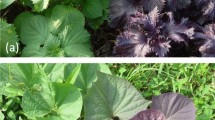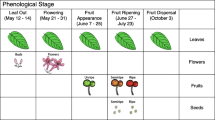Abstract
Phenological synchrony between budburst and emergence of larvae is critical for the fitness of many spring-feeding insect herbivores. Therefore, large intraspecific variation in timing of budburst of the host may have a negative effect on the herbivore. We studied how asynchrony between emergence of larvae and budburst affects the fitness of Operophtera brumata (Lepidoptera: Geometridae), a major defoliator of Quercus robur, which can adapt to the phenology of a single tree. It is known that, in maturing leaves of Q. robur, accumulation of condensed tannins has a negative effect on growth of O. brumata. However, there is no information about the effect of hydrolysable tannins and other phenolics that are potential antifeedants. In this study, we also analysed changes in secondary chemistry of the foliage of Q. robur and how different compounds are correlated with growth and survival of O. brumata. The effect of asynchrony on O. brumata was studied in rearing experiments. The neonate larvae were incubated without food for different periods of time. The decline in nutritional quality of foliage was estimated by rearing cohorts of larvae with manipulated hatching times on the leaves of ten individual Q. robur trees. For the chemical analysis, the foliage of these trees was sampled at regular intervals. In the absence of foliage, mortality of neonate larvae started to increase exponentially soon after the larvae emerged. If the larvae missed budburst, the decline in nutritional quality of the foliage led to increased mortality and lower body mass (= fecundity). Hydrolysable tannins were not significantly correlated with performance of the larvae. Only condensed tannins were found to correlate negatively with the growth and survival of O. brumata. Certain individual trees were unsuitable hosts for O. brumata because the decline in quality of the foliage was very rapid. Based on regression equations for increasing rate of mortality and decreasing fecundity, we calculated that a relatively small mismatch of ±30 degree days between budburst and hatching of larvae leads to a 50% decrease in the fitness of O. brumata. Thus, large phenological variation within a Q. robur stand can limit the colonisation of neighbouring trees by dispersing larvae. Furthermore, the hybridisation of moths adapted to phenologically different trees may lead to maladapted phenology of their offspring.






Similar content being viewed by others
References
Ayres MP, MacLean SF Jr (1987) Development of birch leaves and growth energetics of Epirrita autumnata (Geometridae). Ecology 68:558–568
Ayres MP, Clausen TP, MacLean SF Jr, Redman AM, Reichardt PB (1997) Diversity of structure and antiherbivory activity in condensed tannins. Ecology 78:1696–1712
Chen Z, Kolb TE, Clancy KM (2001) Mechanisms of Douglas-fir resistance to western spruce budworm defoliation: bud burst phenology, photosynthetic compensation and growth rate. Tree Physiol 21:1159–1169
Connor EF, Adams-Manson RH, Carr TG, Beck MW (1994) The effects of host plant phenology on the demography and population dynamics of the leaf-mining moth, Cameria hamadryadella (Lepidoptera: Gracillariidae). Ecol Entomol 19:111–120
Crawley MJ, Akhteruzzaman M (1988) Individual variation in the phenology of oak trees and its consequences for herbivorous insects. Funct Ecol 2:409–415
Du Merle P (1988) Phenological resistance of oaks to the green leafroller, Tortrix viridiana (Lepidoptera: Tortricidae). In: Mattson WJ, Levieux J, Bernard-Dagan C (eds) Mechanisms of woody plant defences against insects. Springer, Berlin Heidelberg New York, pp 215–226
Edland T (1971) Wind dispersal of the winter moth larvae Operophtera brumata L. (Lep., Geometridae) and its relevance to control measures. Nor Entomol Tidsskr 18:103–107
Edmunds GF, Alstad DN (1978) Coevolution in insect herbivores and conifers. Science 199:941–945
Embree DG (1965) The population dynamics of the winter moth in Nova Scotia, 1954–62. Mem Entomol Soc Can 46:1–57
Feeny P (1968) Effect of oak leaf tannins on larval growth of the winter moth Operophtera brumata. J Insect Physiol 14:805–817
Feeny P (1970) Seasonal changes in oak leaf tannins and nutrients as a cause of spring feeding by winter moth caterpillars. Ecology 51:565–581
Fox CW, Waddell KJ, Groeters FR, Mosseau TA (1997) Variation in budbreak phenology affects the distribution of a leafmining beetle (Brachys tessellatus) on turkey oak (Quercus laevis). Ecoscience 4:480–489
Graf B, Borer F, Höpli HU, Höhn H, Dorn S (1995) The winter moth, Operophtera brumata L. (Lep., Geometridae) on apple and cherry: spatial and temporal aspects of recolonization in autumn. J Appl Entomol 119:295–301
Holliday NJ (1977) Population ecology of winter moth (Operophtera brumata) on apple in relation to larval dispersal and time of bud burst. J Appl Ecol 14:803–813
Hough JA, Pimentel D (1978) Influence of host foliage on development, survival and fecundity of gypsy moth. Environ Entomol 7:97–102
Humphrey JW, Swaine MD (1997) Factors affecting the natural regeneration of Quercus in Scottish oakwoods. II. Insect defoliation of trees and seedlings. J Appl Ecol 34:585–593
Hunter AF, Lechowicz MJ (1992) Foliage quality changes during canopy development of some northern hardwood trees. Oecologia 89:316–323
Hunter MD (1990) Differential susceptibility to variable plant phenology and its role in competition between two insect herbivores on oak. Ecol Entomol 15:401–408
Hunter MD (1992) A variable insect-plant interaction: the relationship between tree budburst phenology and population levels of insect herbivores among trees. Ecol Entomol 16:91–95
Julkunen-Tiitto R, Sorsa S (2001) Testing the drying methods for willow flavonoids, tannins and salicylates. J Chem Ecol 27:779–789
Kause A, Ossipov V, Haukioja E, Lempa K, Hanhimäki S, Ossipova S (1999) Multiplicity of biochemical factors determining quality of growing birch leaves. Oecologia 120:102–112
Kolb TE, Teulon DAJ (1991) Relationship between sugar maple budburst phenology and pear thrips damage. Can J For Res 21:1043–1048
Lill JT, Marquis RJ (2001) The effects of leaf quality on herbivore performance and attack from natural enemies. Oecologia 126:418–428
Marino PC, Cornell HV (1993) Adult feeding and oviposition of Phytomyza ilicicola (Diptera: Agromyzidae) in response to leaf and tree phenology. Environ Entomol 22:1294–1301
Mopper S, Simberloff D (1995) Differential herbivory in an oak population: the role of plant phenology and insect performance. Ecology 76:1233–1241
Porter LJ, Hrstich LN, Chan BG (1986) The conversion of proanthocyanidins and prodelphinidins to cyanidins and delphinidins. Phytochemistry 25:223–230
Quiring DT (1992) Rapid change in suitability of white spruce for a specialist herbivore, Zeiraphera canadensis, as a function of leaf age. Can J Zool 70:2132–2138
Quiring DT (1994) Influence of inter-tree variation in time of budburst of white spruce on herbivory and the behaviour and survivorship of Zeiraphera canadensis. Ecol Entomol 19:17–25
Rice WR (1989) Analyzing tables of statistical tests. Evolution 42:223–225
Roland J, Myers JH (1987) Improved insect performance from host-plant defoliation: winter moth on oak and apple. Ecol Entomol 12:409–414
Rossiter MC, Schultz JC, Baldwin IT (1988) Relationships among defoliation, red oak phenolics, and gypsy moth growth and reproduction. Ecology 69:267–277
Scalbert A, Haslam E (1987) Polyphenols and chemical defence of the leaves of Quercus robur. Phytochemistry 26:3191–3195
Scriber JM, Slansky F Jr (1981) Nutritional ecology of immature insects. Annu Rev Entomol 26:183–211
SigmaPlot (1999) SigmaPlot 5.0 Users Guide. SPSS, Chicago
Speyer W (1941) Weitere Beiträge zur Biologie und Bekämpfung des Kleinen Frostspanners (Cheimatobia brumata L.). Arb Physiol Angew Entomol Berlin-Dahlem 8:245–261
SPSS (2000) SPSS Base 10.0 Users Guide. SPSS, Chicago
Tammaru T (1998) Determination of adult size in folivorous moth: constraints at instar level? Ecol Entomol 23:80–89
Tikkanen O-P, Lyytikäinen-Saarenmaa P (2002) Adaptation of a generalist moth, Operophtera brumata, to variable budburst phenology of host plants. Entomol Exp Appl 103:123–133
Tikkanen O-P, Niemelä P, Keränen J (2000) Growth and development of a generalist insect herbivore, Operophtera brumata, on original and alternative host plants. Oecologia 122:529–536
Van Dongen S, Matthysen E, Dhondt AA (1996) Restricted male winter moth (Operophtera brumata L.) dispersal among host trees. Acta Oecol 17:319–229
Van Dongen S, Backeljau T, Matthysen E, Dhondt AA (1997) Synchronization of hatching date with budburst of individual host trees (Quercus robur) in the winter moth (Operophtera brumata) and its fitness consequences. J Anim Ecol 66:113–121
Van Zandt PA, Mopper S (1998) A meta-analysis of adaptive deme formation ín phytophagous insect populations. Am Nat 152:595–604
Varley GC, Gradwell GR (1968) Population models for the winter moth. In: Southwood TRE (ed) Symposia of the royal entomological society of London No. 4. Blackwell, Oxford, pp 132–142
Wint W (1983) The role of alternative host-plant species in the life of a polyphagous moth, Operophtera brumata (Lepidoptera: Geometridae). J Anim Ecol 52:439–450
Acknowledgements
We thank the personnel of the Centre for Ecology and Hydrology Banchory, for their hospitality during the field work. Special thanks to Outi Nousiainen for making the chemical analyses. Susanna Puustinen, Tiina Ylioja and an anonymous referee are thanked for critical reviewing of our manuscript that helped us greatly to improve the text. A grant from the Academy of Finland (71961) made possible the work of O.-P.T. in Scotland. The CEH Banchory provided facilities for the field work and the University of Joensuu for the chemical analyses.
Author information
Authors and Affiliations
Corresponding author
Rights and permissions
About this article
Cite this article
Tikkanen, OP., Julkunen-Tiitto, R. Phenological variation as protection against defoliating insects: the case of Quercus robur and Operophtera brumata . Oecologia 136, 244–251 (2003). https://doi.org/10.1007/s00442-003-1267-7
Received:
Accepted:
Published:
Issue Date:
DOI: https://doi.org/10.1007/s00442-003-1267-7




